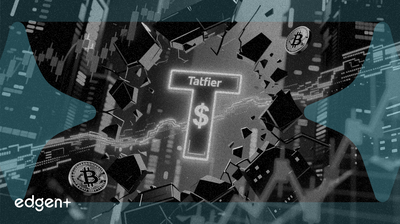
No Data Yet

## Executive Summary Tether has increased the supply of its **USDT** stablecoin by minting 1 billion tokens on the **Tron** network. The move is designed to enhance liquidity but occurs during a period of significant market distress. The broader cryptocurrency market is facing a sharp downturn, with technical indicators for **Bitcoin (BTC)** and **Ether (ETH)** signaling a potential extended bear market. This issuance is set against a challenging macroeconomic backdrop where persistent U.S. Treasury yields and a strong dollar are creating headwinds for risk assets, questioning the immediate impact of the new liquidity. ## The Event in Detail On-chain data confirms that **Tether Treasury** executed a transaction to issue 1 billion **USDT** on the **Tron** blockchain. This action directly increases the circulating supply of **USDT** within the **Tron** ecosystem, a platform known for its high transaction volume and use in DeFi applications. Such an issuance is typically aimed at satisfying market demand, facilitating large-scale trades, and ensuring sufficient liquidity across decentralized exchanges and lending protocols operating on the network. ## Market Implications The injection of $1 billion in stablecoin liquidity could be interpreted in several ways. On one hand, it provides "dry powder" that could be used to purchase volatile assets like **BTC** and **ETH** at lower prices, potentially helping to establish a market floor. On the other hand, in a risk-off environment, the new supply may be used by traders to exit volatile positions and seek refuge in the perceived stability of **USDT**. The move reinforces **Tether's** position as the dominant stablecoin provider, capable of supplying liquidity during periods of high stress. For the **Tron** network, it solidifies its standing as a key hub for stablecoin activity. ## Expert Commentary Market analysts have pointed to overwhelmingly bearish technical signals that temper any optimism from the liquidity injection. According to **CoinDesk** analyst Omkar Godbole, **Bitcoin's** monthly moving average convergence divergence (MACD) histogram has turned negative for the first time since the 2021 market peak, an indicator that has historically preceded prolonged downturns. Concurrently, **Ether** has confirmed a "death cross," where its 50-day moving average has fallen below its 200-day moving average, signaling further bearish momentum. The selloff has been exacerbated by massive deleveraging. Data shows nearly $646 million in leveraged positions were wiped out, with longs accounting for almost 90% of the total. Exchanges like **Binance**, Hyperliquid, and Bybit each recorded over $160 million in liquidations, indicating that heavily leveraged bullish bets were forcefully closed. ## Broader Context This market turmoil is unfolding against a complex macroeconomic picture. Despite expectations of Federal Reserve rate cuts, the yield on the 10-year U.S. Treasury note remains stubbornly above 4%. This resilience is attributed to concerns over fiscal debt and persistent inflation. A stronger dollar index further compounds the pressure on cryptocurrencies, as it makes dollar-denominated assets more attractive. > "As the federal government becomes more deeply indebted, it must issue more bonds—increasing the supply of government debt in the market," noted a Fidelity report. "Without a commensurate rise in demand from buyers, that additional supply could drive yields up." While market prices are volatile, the underlying financial infrastructure of the crypto ecosystem is being tested. Decentralized alternatives like **tBTC** have shown resilience, and developments in native **Bitcoin** programmability continue. However, the current market is dominated by price action driven by macroeconomic fears and large-scale liquidations, making the environment for risk assets, including cryptocurrencies, exceptionally challenging.

## The Event in Detail **RedotPay**, a Hong Kong-based cryptocurrency payment gateway, has announced a strategic partnership with **Ripple** to introduce a new off-ramping service in Nigeria. The feature, marketed as "Send Crypto, Receive NGN," enables users to directly convert a portfolio of major cryptocurrencies into the local fiat currency, the Nigerian Naira (NGN). The service is designed to address a significant friction point in the crypto ecosystem by providing a seamless and direct bridge between digital assets and spendable cash. Supported cryptocurrencies include **Tether (USDT), USD Coin (USDC), Bitcoin (BTC), Ethereum (ETH), Solana (SOL), Tron (TRX), XRP (XRP),** and **BNB (BNB)**. This initiative leverages Ripple's established payment infrastructure to facilitate efficient and reliable cross-border settlements. ## Market Implications The introduction of this service is poised to significantly enhance cryptocurrency utility and adoption within Nigeria, one of Africa's largest and most active crypto markets. By simplifying the process of converting digital assets into Naira, RedotPay and Ripple are lowering the barrier to entry for mainstream users and providing a practical solution for remittances, peer-to-peer transactions, and merchant services. For **Ripple**, this partnership marks a notable expansion of its footprint in the African market. The collaboration demonstrates the utility of its network for facilitating low-cost, real-time payments and highlights a strategic focus on enabling crypto-native financial services in high-growth emerging economies. ## Broader Context This development is part of a larger trend of major financial players entering the African digital payments landscape. It mirrors strategies seen from traditional finance giants like **Mastercard**, which recently partnered with **Axian Group** to roll out digital payment solutions across five African countries, including Tanzania and Senegal. These moves underscore a collective recognition of the continent's potential for financial innovation, driven by a young, tech-savvy population and increasing mobile phone penetration. While the crypto market is known for its volatility compared to traditional assets like gold or stocks, its potential for high growth continues to attract both users and institutional investment. The establishment of compliant and regulated on-ramps and off-ramps is a critical step toward legitimizing the asset class and integrating it into the broader financial system. ## Expert Commentary The strategic rationale behind such partnerships was articulated by Mete Guney, an executive at Mastercard, in a related context, who stated a commitment "to working with innovative players... to drive financial inclusion and accelerate the growth of the continent’s digital economy." This sentiment is directly applicable to the RedotPay-Ripple initiative, which aims to provide tangible financial tools. The market sentiment surrounding the move is largely bullish, with analysts citing its potential to unlock new efficiencies and drive further crypto adoption. By providing reliable infrastructure, companies are betting on the long-term growth of digital assets as a functional component of daily commerce and finance in regions like Africa.

## Executive Summary A Brazilian federal court has delivered sentences ranging from 10 to 21 years to 14 individuals convicted of laundering more than $95 million through **Bitcoin**. The funds were derived from organized criminal activities, including cross-border drug trafficking and kidnapping. This case underscores the increasing use of digital assets by criminal enterprises in Brazil to obscure illicit financial flows and represents a significant victory for law enforcement in the region. ## The Event in Detail The court ruling targeted a criminal group operating primarily in the Brazilian states of Minas Gerais and Paraná between April 2019 and July 2024. The organization systematically used **Bitcoin** to conceal the nature, origin, destination, and ownership of financial assets obtained from violent crimes. The conviction and subsequent sentencing mark the culmination of a federal investigation into the sophisticated use of cryptocurrency for money laundering purposes. ## Broader Context and Law Enforcement Response This sentencing is not an isolated incident but rather indicative of a broader trend in Brazil. Organized crime has been progressively integrating cryptocurrencies into its money laundering operations. In response, Brazilian authorities have intensified their efforts, demonstrating growing sophistication in tracking and prosecuting crypto-related financial crimes. A notable example is **Operation Lusocoin**, a separate, larger investigation that dismantled a network accused of laundering approximately $540 million through digital assets for activities ranging from drug smuggling to terrorism financing. These efforts are increasingly supported by international public-private partnerships, such as the **T3 Financial Crime Unit**, which includes collaboration between law enforcement and key players in the digital asset space like **TRM Labs**, **Tether**, and **TRON**. This framework facilitates the tracing, freezing, and recovery of illicitly used digital assets on a global scale. ## Market Implications The consistent and high-profile nature of these enforcement actions is expected to lead to heightened regulatory scrutiny of the cryptocurrency sector in Brazil. Financial regulators may impose stricter Anti-Money Laundering (AML) and Know Your Customer (KYC) requirements on cryptocurrency exchanges and other virtual asset service providers. The legal precedent set by this case may also increase the perceived risk for financial institutions dealing with crypto-related entities, potentially impacting liquidity and investment in the local market. The focus on specific assets like **Bitcoin** could also lead to more rigorous transaction monitoring on public blockchains by both authorities and compliance firms.

## Executive Summary Asian stock markets experienced a sharp decline, with South Korea's KOSPI index triggering a circuit breaker following a substantial drop, and Japan's Nikkei 225 falling below the critical 50,000-point threshold. This market contraction was primarily driven by investor concerns regarding a potential "AI bubble" and broader market overvaluation. ## The Event in Detail The Korean stock market initiated a significant downturn, with the **KOSPI index** experiencing an over 6% drop and falling below the 4,000-point mark. This led to the **Korea Exchange** activating a circuit breaker on the KOSPI index after **KOSPI 200 futures** declined by 5%, resulting in a five-minute suspension of program trading. Concurrently, Japan's **Nikkei 225 index** dropped below 50,000 points for the first time since October 27, marking a 3.7% decrease. The sell-off was fueled by warnings from Wall Street regarding what is perceived as an overvalued market environment and heightened fears of an impending "AI bubble" burst. This recent decline contrasts with earlier performance where the KOSPI index had surged past 4,200 points to its strongest performance, reaching a historical high of 4,221.87 points towards the end of 2025. ## Market Implications The instability in traditional Asian equity markets had a direct and pronounced impact on the digital asset space. **Bitcoin's** price continued its losses, plunging below $106,000 and reaching a low of $103,768, marking a 3.2% loss over a 24-hour period. This price depreciation contributed to the removal of nearly **$70 billion** from the total cryptocurrency market value. The broader market sentiment in crypto is reflected by the **Crypto Fear & Greed Index**, which plummeted by 21 points to 21/100, signifying "Extreme Fear"—its lowest level since April. This indicates a significant increase in risk aversion across the cryptocurrency sector. Overall, the total crypto market capitalization decreased from **$4.22 trillion** to **$3.43 trillion**, effectively erasing all gains made since the start of 2025. ## Expert Commentary Market strategists and financial figures have been signaling caution regarding current market conditions. Esteemed investors like **Michael Burry** have reportedly been betting against Wall Street, while **Warren Buffett's** valuation gauge has reached record highs, collectively suggesting that financial markets may be entering a perilous phase. Crypto analyst **Ran Neuner** cautioned that even a minor pullback in equities could precipitate further losses in digital assets. In South Korea, **CryptoQuant CEO Ki Young Ju** highlighted a significant shift in investor behavior, suggesting that the South Korean government's policies might be aimed at redirecting speculative capital away from property and digital assets towards the stock market. This perspective aligns with observations of a dramatic decline in crypto trading volume in Korea. ## Broader Context The recent market dynamics underscore a divergence in South Korea's financial landscape. While the KOSPI index had previously achieved record highs, the country's crypto market has simultaneously experienced a significant downturn. Daily trading volume on South Korea's top five crypto exchanges plummeted by over 80%, from **KRW 17.1 trillion** to **KRW 3.2 trillion**. This substantial reduction in trading activity has led to the fading of the "Kimchi Premium," historically seen when cryptocurrencies trade at a higher price in South Korea compared to global markets. Analysts indicate that as traditional markets like the KOSPI ride high, everyday traders in South Korea appear to be returning to stocks, influenced by government efforts to mitigate speculation in alternative assets and by persistent, stringent regulations within the crypto industry.